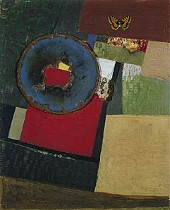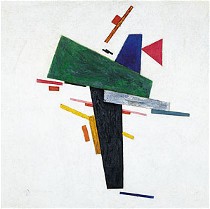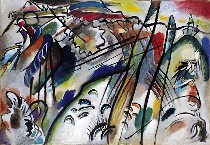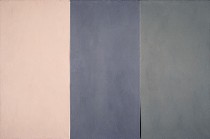Post from Douglas T. Witmer, Part I
 [Editors’ note: Abstract painter Douglas Witmer is reponding to a series of posts on abstract art. He had so much worth saying that we divided his post into two sections. Here’s section one.]
[Editors’ note: Abstract painter Douglas Witmer is reponding to a series of posts on abstract art. He had so much worth saying that we divided his post into two sections. Here’s section one.]…The painter Chris Martin once said “Do what you love as precisely as possible.” I imagine then that a big problem for any artist today (including myself), in a visually super-saturated environment, is discerning what it is that you REALLY love (shown, painting by Agnes Martin, probably not related to Chris).
 If I work on the (naive) assumption that every work of art springs from the artist’s honest personal process, words or categories such as “abstract” or “representational” (or add whatever movement/style you want) have only a little bit of value as related to the actual qualities of the piece. How do you tell, though, if the work is of honest (loving) intent? Yeah, that can be hard (shown, Kurt Schwitters’ Maraak Variation I). But a lot of times intentions show through, don’t you think? …
If I work on the (naive) assumption that every work of art springs from the artist’s honest personal process, words or categories such as “abstract” or “representational” (or add whatever movement/style you want) have only a little bit of value as related to the actual qualities of the piece. How do you tell, though, if the work is of honest (loving) intent? Yeah, that can be hard (shown, Kurt Schwitters’ Maraak Variation I). But a lot of times intentions show through, don’t you think? …
The feeling of seeing
…Related to the discussion of abstraction being apart from the body, I would like to suggest that we feel ourselves seeing. And as a reminder, seeing is a bodily event.
 I think simple seeing is undervalued in the contemporary art environment. (I’m remembering the countless grad school arguments we waged over work none of us had ever actually seen!) In my experience, abstraction, reliant on its retinality, physical properties and free of “recognizable imagery”, is still a powerful format for exploring the sensation of sight and visual perception in a somewhat “pure” way (shown, untitled piece by Kazimir Malevich work).
I think simple seeing is undervalued in the contemporary art environment. (I’m remembering the countless grad school arguments we waged over work none of us had ever actually seen!) In my experience, abstraction, reliant on its retinality, physical properties and free of “recognizable imagery”, is still a powerful format for exploring the sensation of sight and visual perception in a somewhat “pure” way (shown, untitled piece by Kazimir Malevich work). I make personal life connections or experience transformation as I move from my physical feeling of seeing this kind of work inward to the (perhaps no less physical) emotional sensations (feelings) that come next.
…The thing about this description of how abstract art can be experienced is that it makes it seem easy. Which makes me think of music.
Cultural conditioning
 I’ve noticed that folks can listen to instrumental music (which I would argue is more abstract than abstract visual art if only for its added element of time) and find it approachable or engage it in a way they would not do with abstract art (shown, Wassily Kandinsky’s Improvisation 28-Second Version). I’ve never quite understood why this is so, though my hunch is that it has to less to do with the art and more to do with the viewer’s cultural conditioning.
I’ve noticed that folks can listen to instrumental music (which I would argue is more abstract than abstract visual art if only for its added element of time) and find it approachable or engage it in a way they would not do with abstract art (shown, Wassily Kandinsky’s Improvisation 28-Second Version). I’ve never quite understood why this is so, though my hunch is that it has to less to do with the art and more to do with the viewer’s cultural conditioning.
 I’m interested to watch people view my abstract paintings, and I use the instrumental music analogy often and with good success to the ones with the wary expressions. After all, I hope for my work to be seen and have meaning to others (shown, Brice Marden’s D’Apres la Marquise de la Solana).
I’m interested to watch people view my abstract paintings, and I use the instrumental music analogy often and with good success to the ones with the wary expressions. After all, I hope for my work to be seen and have meaning to others (shown, Brice Marden’s D’Apres la Marquise de la Solana).
–Doug Witmer is an abstract painter who shows at Peng Gallery.









